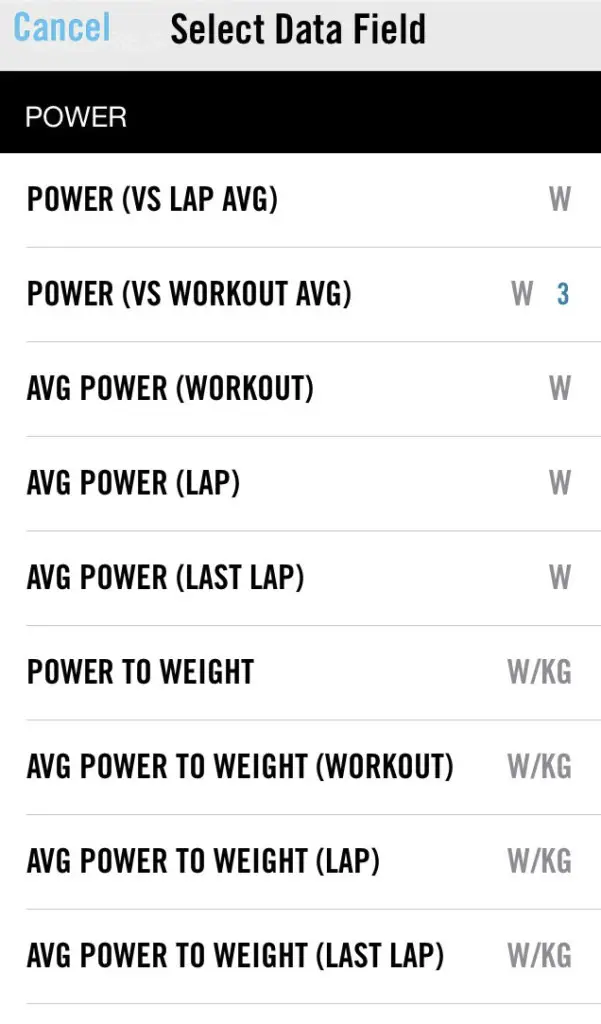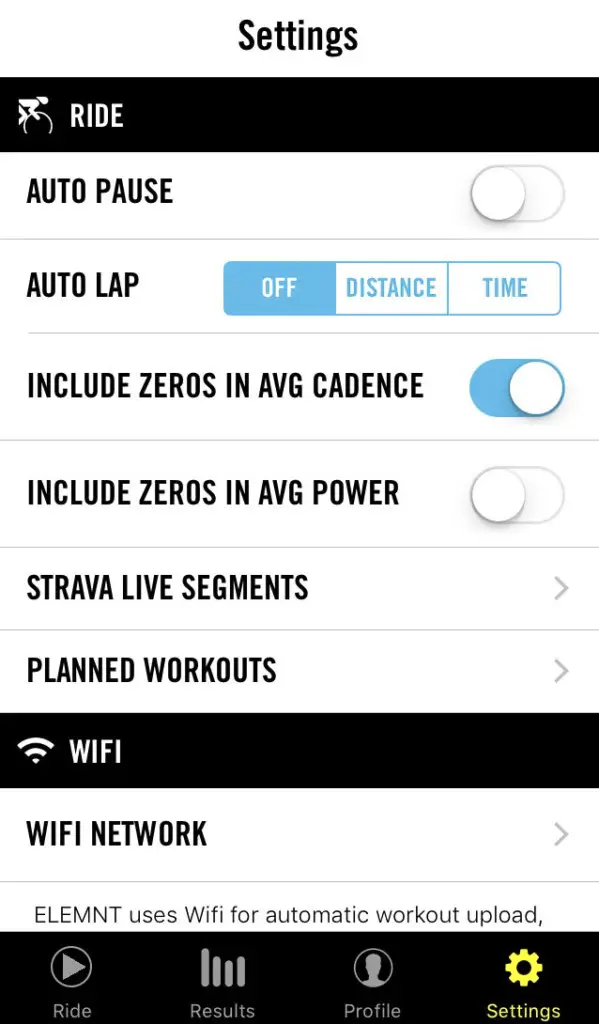A big part of the appeal of gravel riding is the chance to explore areas that you would not otherwise ride. Essential to this experience is having a good map.
There are still a handful of events such as TransIowa (RIP) that only provide riders with a hard copy map and cue sheet, however, most events provide some kind of GPS file of their routes, even if it is a few days before the event.
Having a good cycling computer to stay on track can be an essential part of having a good gravel experience.
One such GPS cycling computer is the Wahoo Elemnt. Offered by the same company that makes the Kickr smart trainer, the Elemnt is a fully loaded computer designed to help you stay on course, track your ride and measure your progress as an athlete.
Read on to find out if the Wahoo Element is the right navigator for your next adventure afield and a useful tool for doing your next set of intervals.
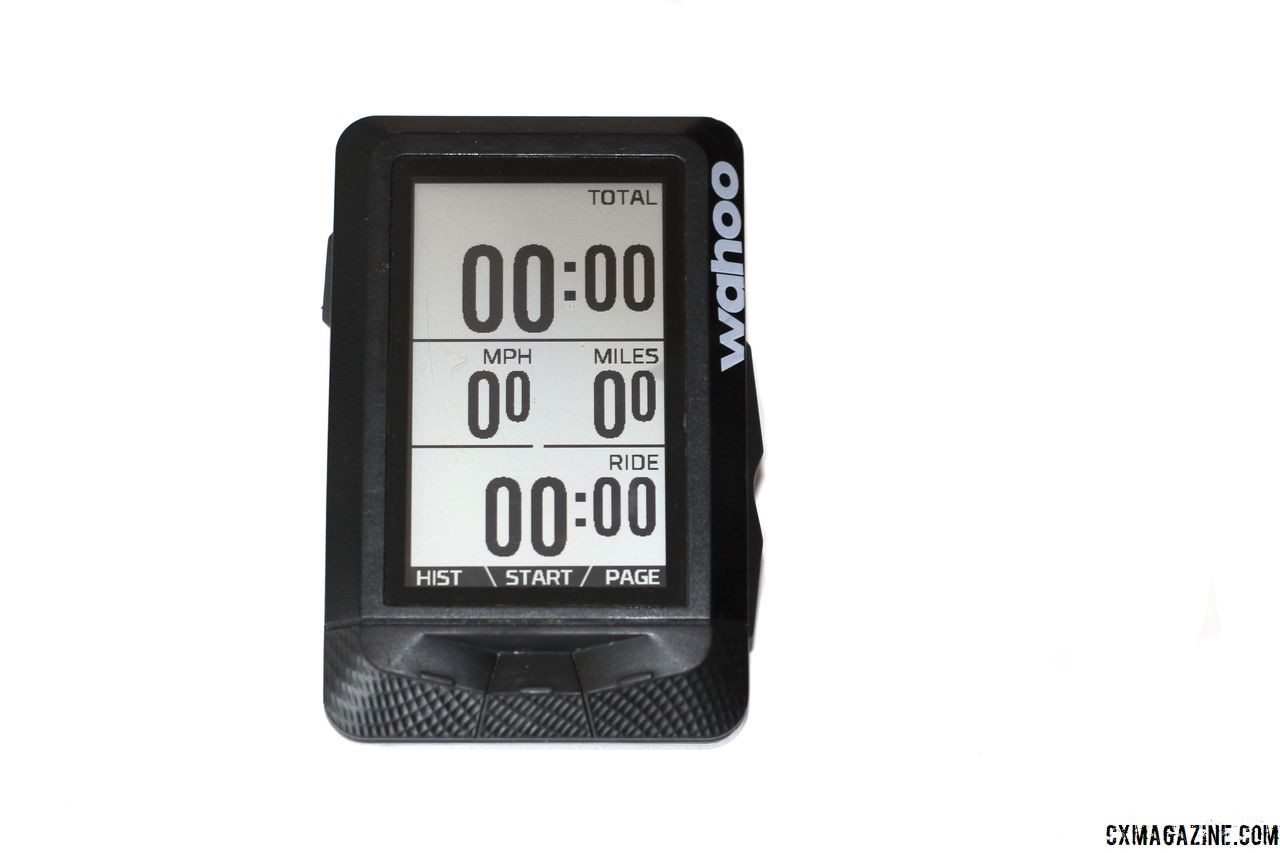
The $300 Wahoo Elemnt GPS Cycling Computer. © Z. Schuster / Cyclocross Magazine
The Wahoo Elemnt Cycling Computer
The Wahoo Element is the company’s flagship bike computer. Whereas other units such as the Garmin Edge 130 we recently reviewed are built to be compact, the Elemnt is more concerned about providing easy-to-read data and a full array of training features.
The Elemnt package comes with the computer, three different mounts and a USB cable to charge the unit and transfer data, if necessary.
The Elemnt measures 2.3″ x 3.5″ x 0.8,” which is relatively big compared to some other units. As might be expected, weight weenies probably need not apply, with the Elemnt checking in at 103g.
If you are looking for a more compact option from Wahoo, the company offers the Bolt, which offers nearly all the same features, but has a smaller screen and is lighter and more aero. The Bolt costs $250 to the Elemnt’s $300 retail price.
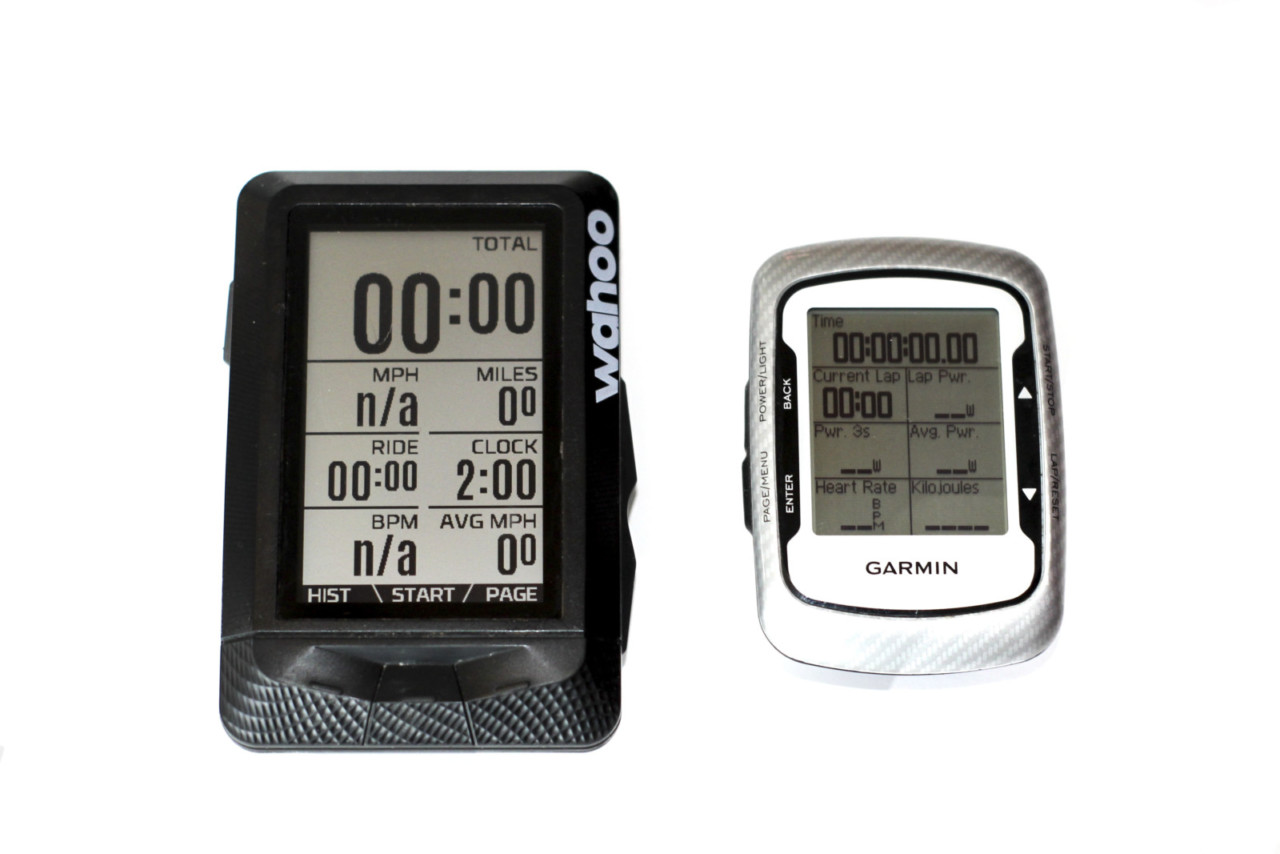
The Elemnt is bigger than more compact computers like the Garmin Edge 500. Wahoo Elemnt GPS Cycling Computer. © Z. Schuster / Cyclocross Magazine
However, if a few extra ounces are no concern, the Elemnt packs a lot into one bike computer.
Displays for the Elemnt unit are controlled via a smartphone and Bluetooth connection. The Wahoo Elemnt app allows you to change preset data pages and customize your own, depending on your training and riding needs. It also offers controls for options such as auto pause, live track and phone and text message display.
The computer has GPS tracking and supports both Ant+ FE-C and Bluetooth connections for sensors such as power meters, heart rate monitors and cadence sensors.
The data fields available for the Elemnt are impressive. It offers all the options you likely need for power, cadence, heart rate, distance, climbing, speed, muscle oxygen and more. There are 77 different options for power, 14 for heart rate and 13 for climbing, as some examples of the options available.
The large screen can display up to 11 fields at once. I found the display for 7 fields to be more than adequate for easy reading.
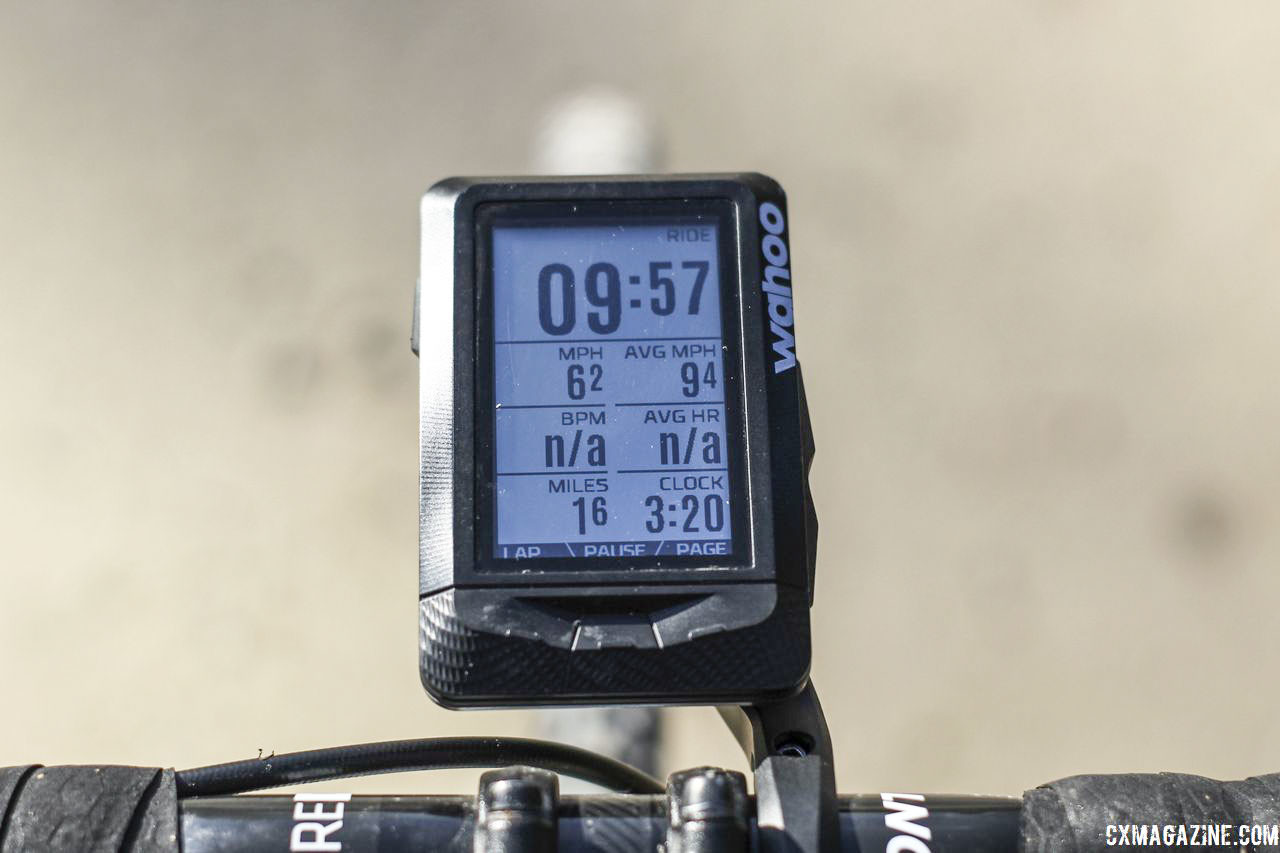
The Elemnt displays up to 11 data fields. Seven fields fit the screen nicely. Wahoo Elemnt GPS Cycling Computer. © Z. Schuster / Cyclocross Magazine
Wahoo ships the unit with three mounting options: out front, stem and aero. The stem mount requires zip ties to secure it to the stem, which can be a bit of a pain if you frequently swap the Elemnt between bikes. I prefer Garmin’s mount that uses a removable rubber piece to secure the mount to the stem.
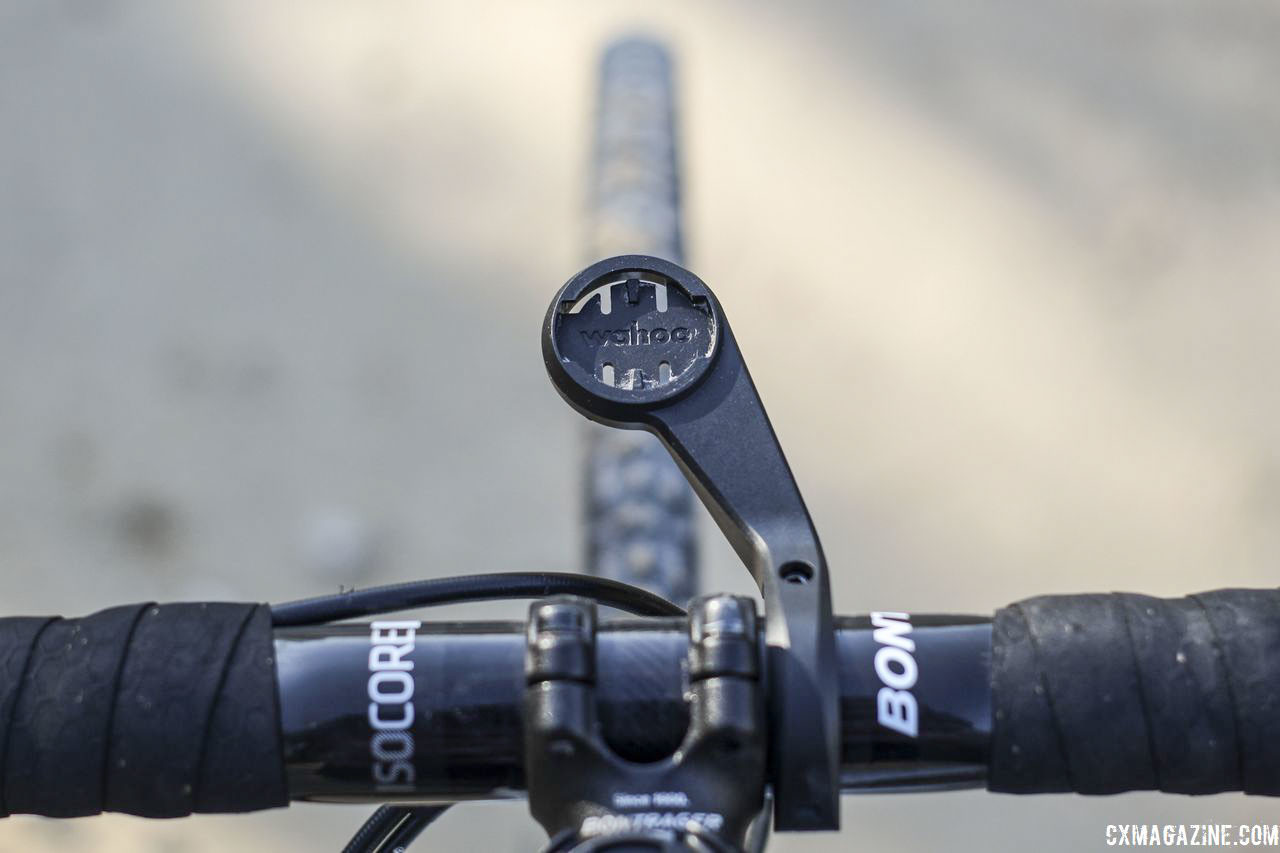
An out front mount is one of three that comes with the Elemnt. Wahoo Elemnt GPS Cycling Computer. © Z. Schuster / Cyclocross Magazine
Good battery life is a must for gravel, and the USB rechargeable battery in the Elemnt gets a claimed 17 hours. I found that my unit lasted about 12-14 hours with a heart rate monitor attached.
Data Access
Once your ride is complete, accessing data from your Elemnt is straightforward.
Since the device is fully Bluetooth integrated, it uploads your ride to your smartphone using the Elemnt app. The Elemnt also uploads your activities to external apps such as Strava and MapMyRide.
Upload speeds are fast, and with a good connection, your rides will be ready to view in less than a minute. It is worth noting that upload speeds were much faster than I experienced with the Garmin app connected to the Edge 130.
The Elemnt app also allows you to use wifi to download software and route updates and then transfer them to the unit when connected.
Elemnt Navigation
When I was attended the Almanzo 100 last year with a number of other cycling journalists, many of them were using the Elemnt, thanks in part to the map feature. After reviewing the Elemnt, I saw why it was a popular choice among that savvy crowd.
The Elemnt comes with global maps for five continents and the option to download others. The maps are incredibly detailed with roads, bike paths and even mountain bike singletrack.
Routes via GPS files for gravel rides are easy to sync to the Elemnt with training apps such as Ride with GPS, Strava and Komoot. Ride with GPS and Komoot routes provide the added benefit of turn-by-turn navigation on the screen.
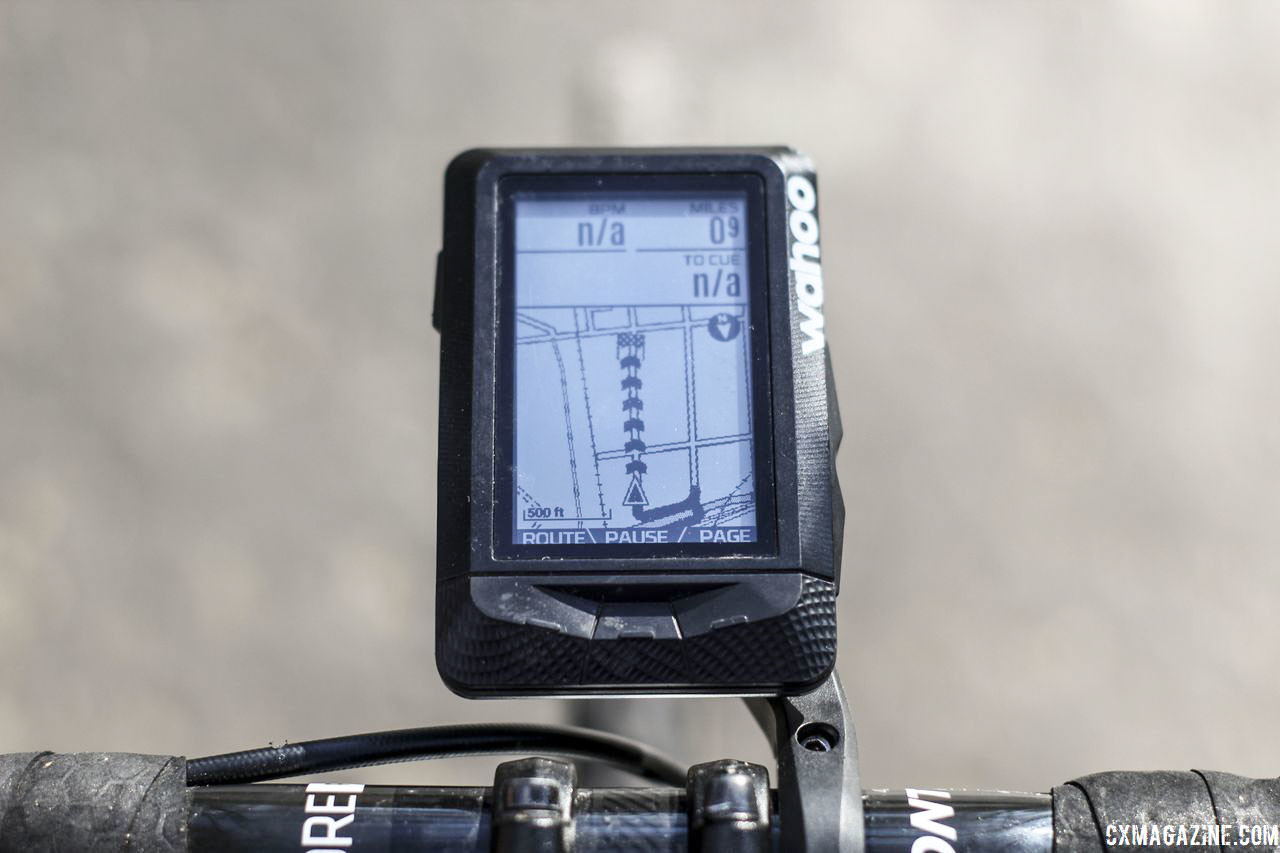
Following a route is a snap with the built-in base map and route tool. Wahoo Elemnt GPS Cycling Computer. © Z. Schuster / Cyclocross Magazine
The routes on the map are easy to follow, and should you get off-course, the built-in maps make it easy to navigate back to your intended route.
The map screen on the Elemnt also allows you to add data fields above the map, allowing you to track your progress and maybe stay within your limits when tempted to hang with the Ted King group at a big gravel event.
Training with the Elemnt
For many, gravel is appealing because it is the opposite of structured training.
However, being on form for cyclocross and road often requires structured workouts. The Elemnt can also help the Type A bike riders out there.
The Elemnt allows you to load structured workouts from apps such as TrainingPeaks. If you are riding outside, the unit gives you cues for time and power targets.
Riding inside, the Elemnt connects to the Wahoo Kickr and other trainers with Ant+ FE-C connectivity. If you are doing a workout, the FE-C control will go into erg mode and provide the prescribed amount of resistance.
If the day’s plan calls for less structure, the Elemnt allows you to set the power (erg mode) or resistance of the trainer. It also offers a Passive Mode, which allows you to use the unit to display data while using an app such as Zwift or TrainerRoad.
If Strava segment hunting is part of your training, the Elemnt offers easy-to-use Strava Live segments. To select segments to target, “star” them in Strava, and then the next time the unit syncs, they will be uploaded to the Elemnt.
The display for the Strava Live segments is pretty impressive. The Elemnt gives you a warning about 1,000 feet out that the segment is approaching. Then when you hit the segment, it gives you a very emphatic go. It tracks your time within the segment, the distance to the end and how your time compares to either your PR or goal you have set in the Strava app.
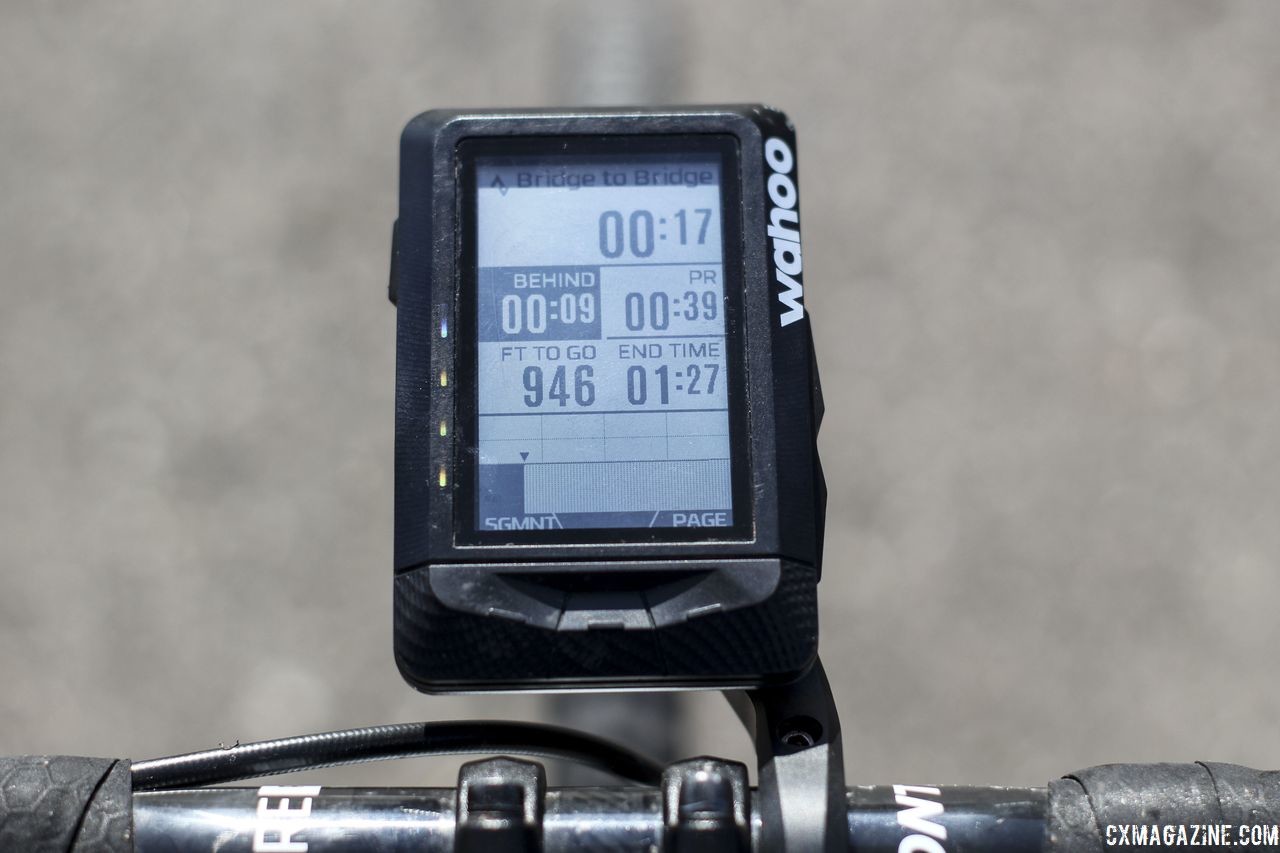
The Elemnt gives you all the data you need for Strava Live segments to take the QOM/KOM. Wahoo Elemnt GPS Cycling Computer. © Z. Schuster / Cyclocross Magazine
Most of us (all?) will never be the next Phil Gaimon, but it can provide a useful tool for beating PRs and setting targets to go after.
Wahoo Tickr
One of the accessories Wahoo offers for use with its computers is the Tickr chest-strap heart rate monitor. The Tickr easily connected with the bike computer and worked as advertised.
The nice thing about the Tickr compared to some other heart rate monitors is that it is both Ant+ and Bluetooth compatible. The Bluetooth compatibility is especially nice if you are running Strava or a training app off older iPhones that only have Bluetooth capability.
The Tickr retails for $50.
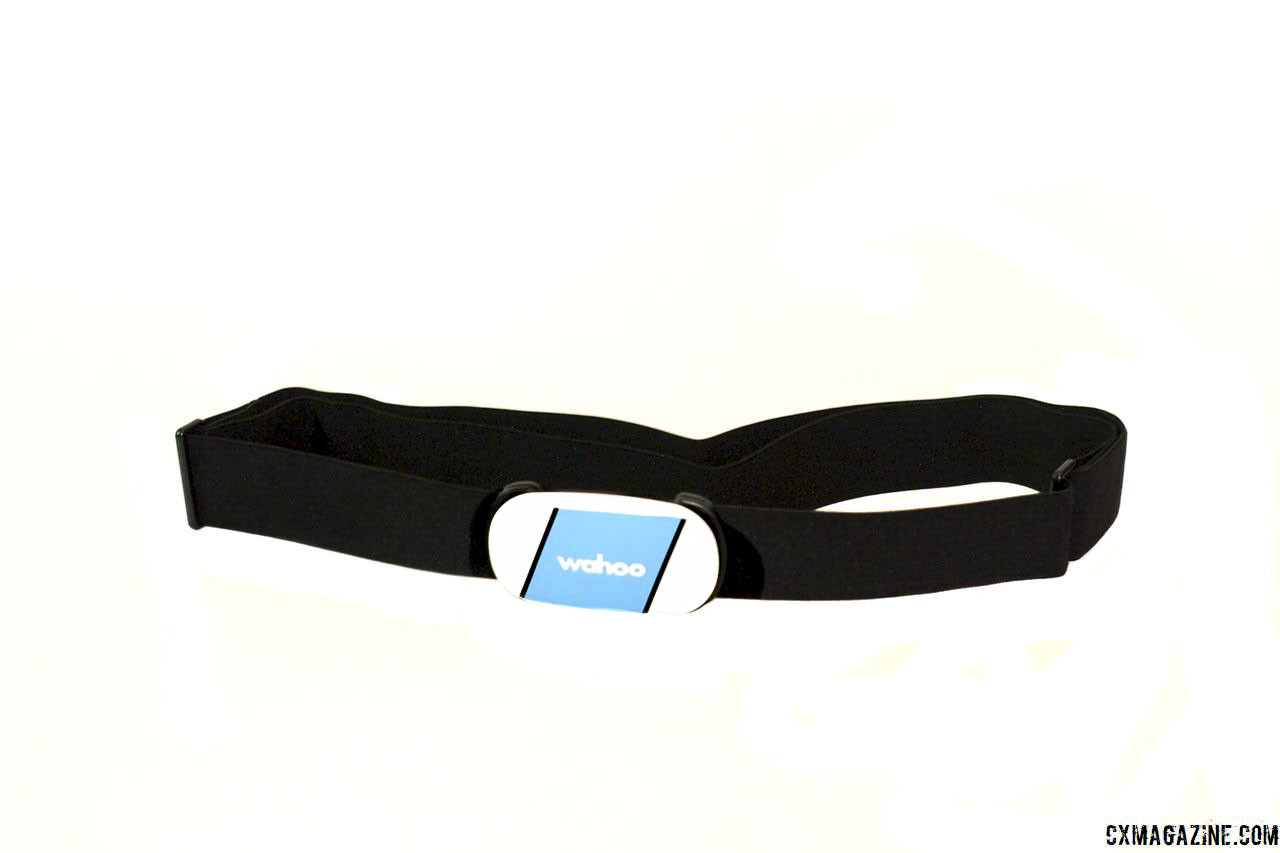
The Tickr is Wahoo’s heart rate monitor. Wahoo Elemnt GPS Cycling Computer. © Z. Schuster / Cyclocross Magazine
Ride Impressions
After riding on and off-road with the Elemnt, I have been very happy with its performance.
I have always used a stem mount, so the big computer unit and out front mount took a bit getting used to, but I have adapted pretty quickly. Even with the large size, the Elemnt integrated nicely with the stem mount on my mountain bike during singletrack riding.
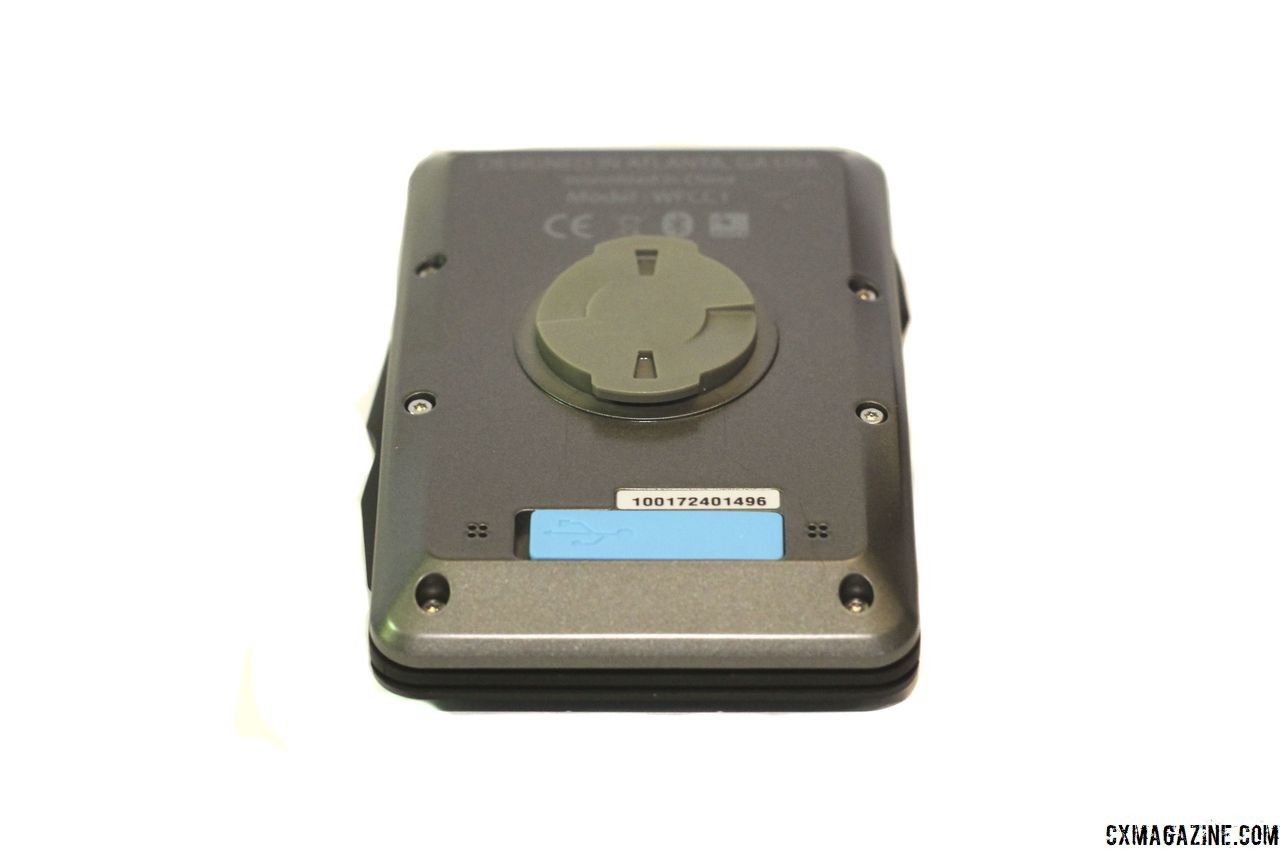
The Elemnt is easy to connect to a mount and to a power source or computer via the USB port. Wahoo Elemnt GPS Cycling Computer. © Z. Schuster / Cyclocross Magazine
The customizable display pages provided all the data I was looking for whether outside with a heart rate monitor or inside with my smart trainer. The fields are easy to adjust using a smartphone—although having to get out the phone to make mid-ride changes such as turning auto-pause on or off took a few extra seconds.
Where I expected the Elemnt to shine—the map and route functions—it did. The integration with Ride with GPS and Strava makes creating and uploading preset routes a snap. The map is easy to read and the routes easy to follow, especially with the turn-by-turn directions from Ride with GPS.
When workouts are done, they are easy to quickly upload to the Elemnt app and then Strava. It easy to start analyzing data and collecting those Strava kudos.
Finally, the battery life for the unit was more than adequate. Twelve hours with sensors attached seems like a good battery life for gravel events and long road rides, and the Elemnt achieves that.
If you turn in a DK200-winning time, the Elemnt should have enough battery to get you back to Emporia without a charge, and if you use it for regular riding, you probably only have to charge it about once a week.
The Verdict
The Wahoo Elemnt GPS cycling computer proved to be a great fit for gravel events. The versatile map, easy-to-read display and adequate battery life made it perfect for staying on track on roads less traveled.
The Elemnt also has a number of features that make it a good option for training. A wide range of available data fields, workout mode and Strava Live segments give you all the data you need to crush your workout.
Due to its size, the Elemnt is best suited for gravel rides where weight is not the biggest issue and training. For road and mountain bike races where those extra grams can weigh you down, a more compact unit such as the Garmin Edge 130 or Elemnt Bolt is likely more desirable.
Also, at $300, the Elemnt is not the cheapest cycling computer out there, but if you are planning on doing a lot of long rides or intense training, the unit has features that will likely make the extra premium you paid feel worth it.
For cyclocross, the Elemnt is pretty big and more likely to fall off in a crash than a small unit. It will, however, fit on most stems, so if you are worried about getting lost on the ’cross course, well, I’m not sure if your local cyclocross course will be uploaded to Wahoo’s impressive map library.
For more on the Elemnt, see the specs below.
This post has been updated to reflect the new $300 sale price on the Elemnt.
Wahoo Elemnt Specifications
Price: $300
Weight: 103g
Dimensions: 2.3″ x 3.5″ x 0.8″
Connectivity: Ant+ FE-C, Bluetooth
Battery: USB Rechargeable, 12-14 hours battery life
Accessories: Three mounts, USB cable
More Info: wahoofitness.com













